#paludirex
Text
Paludirex: Life of the Swamp King
Having gotten the long taxonomic history of Pallimnarchus and Paludirex out of the way (see here), lets talk more about the animal itself.
As far as we know at this point in time, Paludirex was the last of the large semi-aquatic mekosuchines and the largest members of this group had ever gotten. Whereas the cleaver-headed Baru dominated the waterways of the Oligocene and Miocene, Paludirex lived from the Pliocene and Pleistocene. There is some division between the species tho as it appears. Given the ambiguity around the origin of some Paludirex vincenti specimens, this species is currently only known from the Pliocene, whereas Paludirex gracilis is currently only known from the Pleistocene. There may also be a third species from the same region as Paludirex vincenti.
Comparisson between Paludirex gracilis (left) and Paludirex vincenti (right)

Anatomically, Paludirex has a pretty easily recognizable animal. Unlike Baru, with its short, triangular skull, Paludirex had a head that was almost rectangular when viewed from above, about half as wide as long and comparably flat. Mind you the skull can still be pretty deep, especially in Paludirex vincenti, but the proportions still highlight how wide it is most of all. In both robustness and skull width, Paludirex far exceeds what is known in modern saltwater crocodiles, which likely fill a similar niche.
Left: Skull reconstruction of Paludirex vincenti.
Right: Life reconstruction of Paludirex (Nellie Pease)


As said before, Paludirex represents the biggest mekosuchine. At a minimum length of 4 meters, it already rivals many of today's crocodiles and Baru, and that's just the smaller ones. Large individuals of Paludirex vincenti probably got much larger, 5 meters and more further drawing parallels to todays salties.
A size comparisson between Steve Irwin and both species of Paludirex
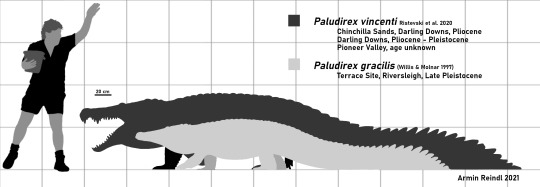
Now while the description is pretty sound on account of recent work by Ristevski and co., the ecology is a different matter. A lot of work was published back when Pallimnarchus was still a thing, so trying to separate what and what isn't applicable these days is a bit of a challenge.
On the most simple level, Paludirex was a generalist semi-aquatic ambush hunter. It's skull, tho incredibly robust and wide, shows no peculiar adaptations like long slender jaws so its obviously not a specialist. It's semi-aquatic because the nostrils and eyes face up so that they would peer out from the water while the rest of the body remained submerged. And these last two together basically suggest ambush-hunting.
Willis and Molnar also made comparissons between Paludirex skulls (or rather skulls now recognized as such) and Mugger crocodiles. All in all this suggests that its diet could have ranged from turtles to aquatic birds to large mammals (so the typical croc range really). They also infer that it may have had similar habitat preferences, being found in marshes, swamps, rivers, lakes, anywhere theres freshwater really. One exception may be that some researchers have argued that Paludirex was avoiding saltwater and brackish water, which eventually could have factored into its extinction once inland waterways in Queensland dissappeared.
Top: Eastern Sahul megafauna, the foreground features Paludirex about to ambush a giant kangaroo (Ryan Bargiel, Vlad Konstantinov, Andrey Atuchin & Scott Hocknull)
Bottom left: Paludirex vincenti (Diego Ortega Anatol)
Bottom right: An unforunate Paludirex being attacked by a marsupial lion (Joschua Knüppe)

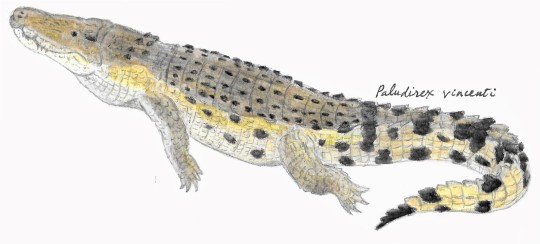

As with many crocs, its pretty likely that individuals were hostile towards each other at certain times, perhaps during territorial disputes or in the mating season. Now this one's a bit of a more ambiguous one regarding the assignment of the fossils. Fossils of leg material show clear bite marks, HOWEVER, the fossils were assigned to Pallimnarchus purely on the basis that they don't appear to have belonged to a terrestrial animal (as often inferred for Quinkana) nor to a modern croc. Based on this, the material was assumed to have been that of Pallimnarchus without much else to back it up. Now that Pallimnarchus is no more, it is reasonable to assume that it may be Paludirex but then again, it could also be an entirely different animal. Only way to tell would be to find Paludirex fossils with leg fossils attached.
This does bring up the interesting discussion, what crocs did coexist with Paludirex? Well there's a couple. As just mentioned, there's Quinkana, which I'll research more in depth later, but for now it's commonly assumed to be more terrestrial than other mekosuchines. There's the Darling Downs form, which lived around the same time as Paludirex vincenti in Queensland and may be a third species of this taxon. Gunggamarandu is another animal from this region, tho much as with Paludirex its not entirely clear if its Pliocene or Pleistocene. More certain is the fact that during the Pleiostocene, Paludirex gracilis coexisted with freshwater crocodiles in the Riversleigh WHA. Finally, there's indetermined species of crocodiles that date as far back as the Pliocene. Historically, they've been regarded as salties, but more recently it's though that they were a different species entirely and that salties only moved in recently, possibly after Paludirex went extinct and the niche of large semi-aquatic predator was free.
Top left: Quinkana faces off against Megalania (Hodari Nundu)
Top right: A freshwater crocodile running (Brandon Sideleau)
Bottom: Gunggamarandu, a relative of today's gharials (Eleanor Pease)


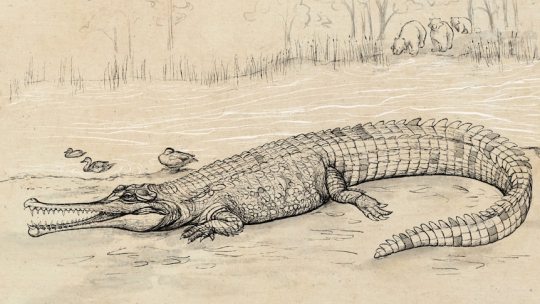
By this point I've basically already given away the reason why Paludirex is no more. With mekosuchines already taking a massive hit during the late Miocene, the group was not at its peak when Paludirex came around. And things were not getting any better as Australia grew more and more arid, river systems disappearing, freshwater drying up and the habitat of these animals shrinking bit by bit. Paludirex, presumably staying clear of coastal waters, was hit hard by these events and eventually it was just too much. And once it was out, saltwater crocodiles moved in, leading into the modern day.
#paludirex#pallimnarchus#palaeoblr#pliocene#pleistocene#australia#paleontology#prehistory#crocodile#croc#crocodilia#mekosuchinae#gunggamarandu#paludirex vincenti#paludirex gracilis#quinkana
116 notes
·
View notes
Text
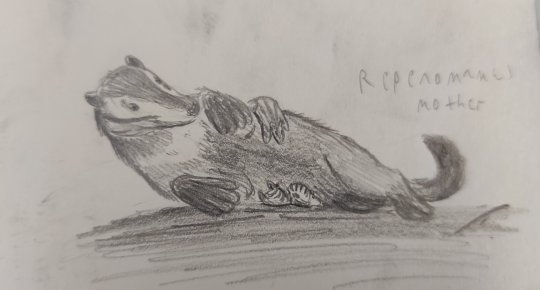
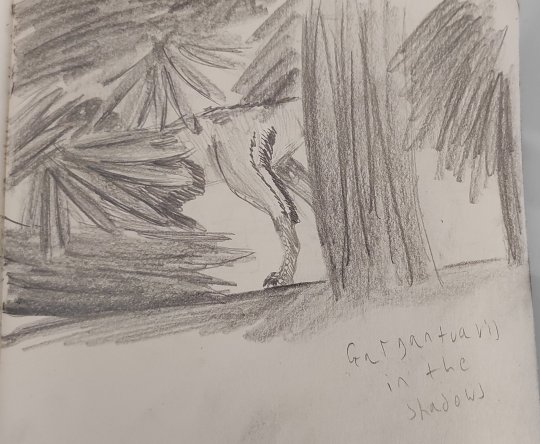

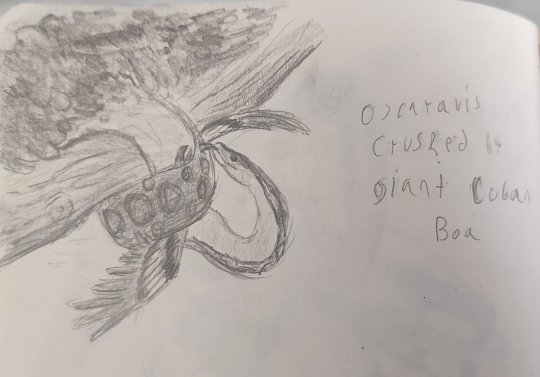
From last night's #paleostream An unfortunate Oscaravis caught in the coils of a giant Cuban Boa Paludirex flat and vibing Gargantuavis lerks in the shadows Repenomamus mother relaxing with her young
81 notes
·
View notes
Text


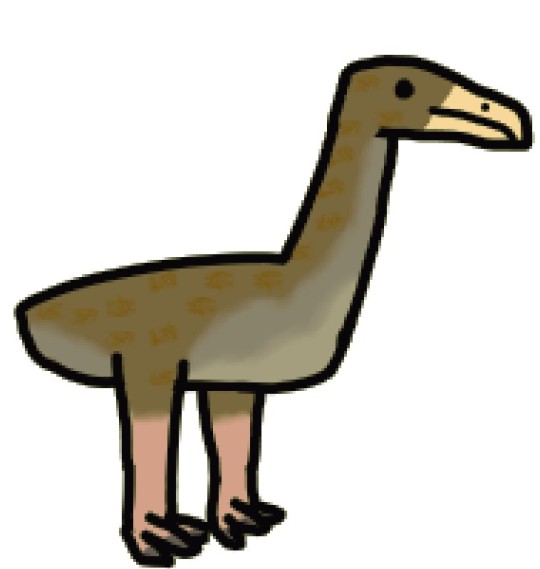
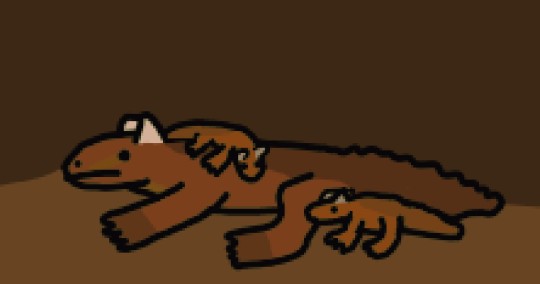
Flocking Together
Oscaravis
Paludirex
Gargantuavis
Repenomamus
6 notes
·
View notes
Text
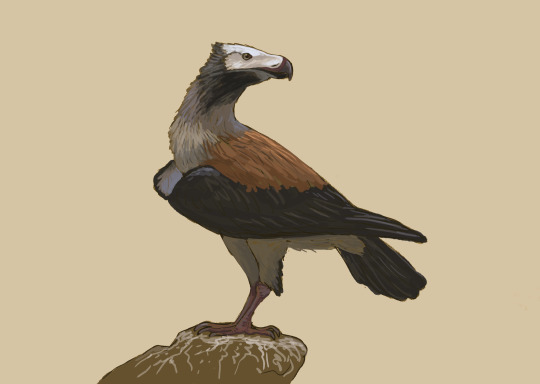



Results from the Flocking #paleostream! Oscaravis, Paludirex, Gargantuavis and Repenomanus.
405 notes
·
View notes
Link
A new taxon of broad-snouted mekosuchine crocodile has been described from Queensland: Paludirex vincenti, literally “Vincent’s Swamp King”. The croc measured at least 5m long, making it about the same size as a modern Saltwater Crocodile (Crocodylus porosus), currently the largest crocodilian in the world.
Link to original open access paper here
28 notes
·
View notes
Text
Prehistoric 16-foot crocodile nicknamed 'swamp king' terrorized Australia 5 million years ago
Prehistoric 16-foot crocodile nicknamed ‘swamp king’ terrorized Australia 5 million years ago
Scientists have just identified a prehistoric crocodile measuring more than 16 feet long that stalked the swamps of Australia millions of years ago.
Fossils of Paludirex vincenti, nicknamed the ‘swamp king,’ were first unearthed in the 1980s but the creature was only recently identified as a distinct species.
It was an apex predator that preyed on giant prehistoric kangaroos in south…

View On WordPress
0 notes
Text
Crikey! Massive prehistoric croc emerges from South East Queensland
Crikey! Massive prehistoric croc emerges from South East Queensland
IMAGE: The ‘swamp king’ was one intimidating croc.
view more
Credit: The University of Queensland
A prehistoric croc measuring more than five metres long – dubbed the ‘swamp king’ – ruled south eastern Queensland waterways only a few million years ago.
University of Queensland researchers identified the new species of prehistoric croc – which they named Paludirex vincenti – from fossils first…

View On WordPress
0 notes
Text
Ancient 'swamp king' monster croc once terrorized Australia
Ancient ‘swamp king’ monster croc once terrorized Australia
A monster croc spanning 16 feet (5 meters) ruled the waterways of south-eastern Queensland in Australia millions of years ago.
Researchers from the University of Queensland identified the reptilian giant — now dubbed “swamp king” — after studying its fossilized 25-inch-long (65 centimeters) skull, which was first uncovered in the 1980s.
In Latin, the genus name Paludirex translates to “swamp…

View On WordPress
0 notes
Text
Trovato in Australia il fossile di un enorme coccodrillo del Pliocene
Trovato in Australia il fossile di un enorme coccodrillo del Pliocene
Paludirex vincenti appartiene ai Mekosuchinae, una sottofamiglia estinta di coccodrilli dell’Australia e del Sud Pacifico.
Un nuovo genere e una nuova specie di coccodrillo preistorico, Paludirex vincenti, è stato identificato da fossili rinvenuti nel Queensland, Australia.
Paludirex vincenti ha vagato per il nostro pianeta durante l’epoca pliocenica, tra i 5 e i 2,5 milioni di anni…

View On WordPress
0 notes
Text
Pallimnarchus and Paludirex: A History of the Swamp Kings
This is only part one of a two part series, ecology and anatomy will be discussed in part 2 because theres just too much history to cover.
Paludirex is a fascinating genus with a complex history. You see, while it was only named 3 years ago, it actually serves as a direct successor to the first fossil croc to have been described from Australia, all the way back in 1886.
Back then, a certain Charles Walter De Vis discovered a multitude of croc fossils in Queensland, specifically the Darling Downs region. Now with all due respect, while De Vis was definitely an important researcher...some of his work doesn't really hold up. In the case of these specific fossil remains, we now know that the fossils belonged to multiple specimens and at least THREE different species. De Vis also straight up admitted that he was not very familiar with Cenozoic crocodiles, which is why he didn't name it....well, sorta. De Vis did in fact not describe a new genus that much is true, however, he did give the material the name Pallimnarchus pollens. De Vis explains that he did so out of convenience and to some degree its understandable. It's always easier to refer to an animal by name than the specimen number, like the Darling Downs Taxon we'll discuss in part 2. But by making it sound like a proper scientific name, De Vis kinda set things up to get messy later.
Charles Walter De Vis (left), multiple fossils originally attributed to Pallimnarchus including those now attributed to Quinkana in B (right)

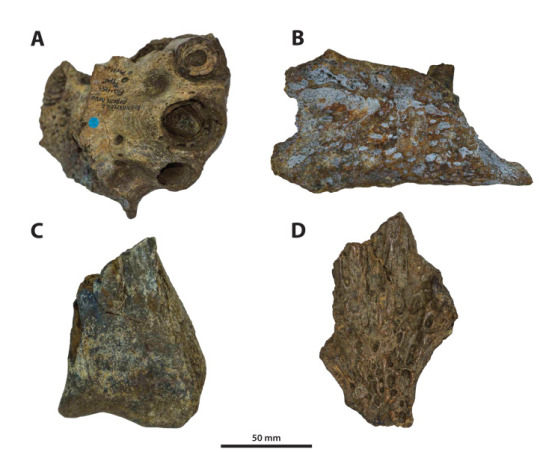
Sure De Vis only meant for Pallimnarchus to be an unofficial name, but subsequent authors didn't exactly bother ammending that fact. Instead, more and more research was published referring material of Australian crocodiles to Pallimnarchus without further question. This largely went unchecked until 1982, when famed Australian paleontologist Ralph Molnar chimed in. Molnar recognized the issues with Pallimnarchus and, in an effort to clear things up, decided to do what should have been done long ago. He picked out the best fossil of De Vis' collection, a lower jaw, designated it as the lectotype and described it in full to establish how it differed from other crocs of the region. Sadly, Molnar was a couple of years too early. In 1982, there were only four crocs to compare it to. The Saltwater Crocodile, the Freshwater Crocodile, the New Guinea Crocodile and Quinkana. What Molnar couldn't have known is that only 8 years later, the fossil record of Australian crocs would change forever with a sudden boom of research describing a plethora of new forms, the Mekosuchinae. So while Molnar's comparisson was adequate for the time, it soon turned out to just not be enough.
Ralph Molnar (left), the lectotype of Pallimnarchus with the only still known material highlighted (right)


Aside from scientists naming a metric shit ton of other crocodiles from the continent, three other important things happened during the 80s and 90s. Firstly, we finally found more good Pallimnarchus fossils. Remember, the De Vis fossils were largely a collection of random, unrelated fossils, the lectotype a partial lower jaw and the only good cranial fossil was the Lansdowne Snout, which people constantly argued over whether or not it was Pallimnarchus or simply a salty. But now we got two pretty great fossils. There is the Mirani Shire Skull, certainly the lesser of the two because someone encased the entire top half in concrete (thanks for that). And then there's the Dalby Specimen, better known as Geoff Vincent's Skull, an incredibly informative collection of skull fragments of a single individual and probably one of the best fossil of this animal.
The second major thing to happen is that in 1997, Molnar teamed up with Paul Willis, who basically had a hand in nearly every described mekosuchine, and once again reevaluated Pallimnarchus. The main takeaway of their work was that they now recognized a second species which they dubbed Pallimnarchus gracilis.
And then there's the third thing. The lectotype was lost and only a small fragment was ever found again. Things were not looking good.
A photograph of Paul Willis (left) and multiple older images of Geoff Vincent's skull (right)


More and more mekosuchines were described in the 2000s, yet things went mostly quiet around Pallimnarchus. The redescription insufficient, the lectotype lost, it had essentially landed in taxonomic limbo with no clue whether or not the name itself was actually valid.
Enter Jorgo Ristevski. Somewhat of a rising star in Australian fossil croc research, Ristevski and several other authors (including Molnar) published a paper meant to finally deal with the issue of Pallimnarchus. Their conclusion, well, sadly Pallimnarchus is a nomen dubium. It's not really a shock given that none of the previous papers ever established any actually unique traits and no such traits could be found in what little remains of the lectotype, but it was an important step none the less. So what now, this historically important genus with countless of referred specimens is no more. Well, thank fuck we got Geoff Vincent's skull.
Yes, with how well preserve that fossil is, Ristevski and colleagues managed to use it to establish a new genus that was meant to serve as a successor to Pallimnarchus, effectively meant to house the material previously assigned to the dubious genus. To honour the legacy of Pallimnarchus, they named this new genus Paludirex, both names translating to "swamp king". Of course with so much material, it was hard to evaluate everything. But there's some key finds. In addition to the Geoff Vincent's skull, both an isolated snout fragment and the Mirani Shire skull could be attributed to Paludirex vincenti, the new type species. Ristevski also confirmed the validity of Pallimnarchus gracilis (now Paludirex gracilis), tho restricting it to two fossils found in the Riversleigh WHA. Furthermore, earlier this year Ristevski was also able to confirm that the Lansdowne Snout belonged to Paludirex as well.
Jorgo Ristevski with the skull of Baru (left), skeletal reconstruction of the skull of Paludirex vincenti (right)
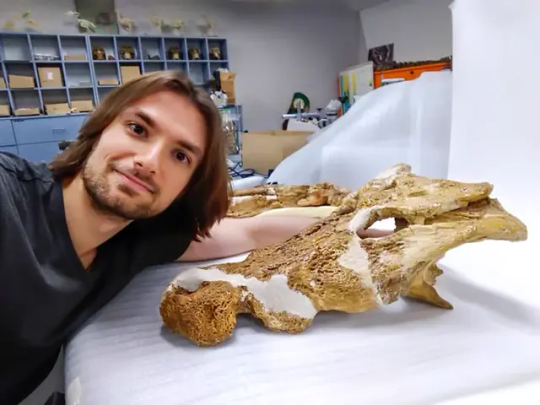
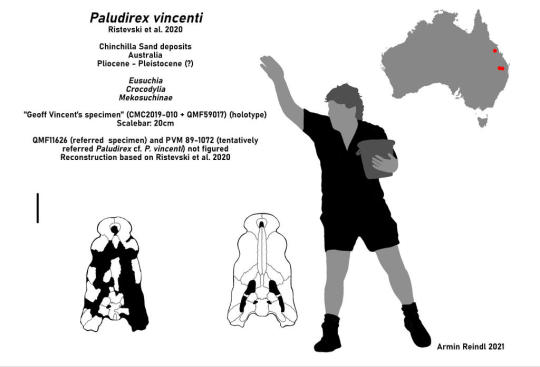
That does still leave a lot of material of course. Since Pallimnarchus was defined based on its lower jaw, and Paludirex has no lower jaw material to speak of, we can't actually confirm if any of the former Pallimnarchus mandibles are referrable to Paludirex. This lack of overlap also creates the fascinating hypothetical that, should we rediscover the lectotype and lower jaw material associated with Paludirex material, then it may be possible that the two become synonyms once more....or that we had two animals on our hands all along. But first we would need to find more material and that may still take a while.
#pallimnarchus#paludirex#palaeoblr#prehistory#cenozoic#mekosuchinae#croc#crocodile#paleontology#long post
23 notes
·
View notes
Text
A massive prehistoric crocodile "Swamp King" emerges from the southeast of Queensland
A massive prehistoric crocodile “Swamp King” emerges from the southeast of Queensland
The ‘Swamp King’ was an intimidating crocodile. Photo credit: University of Queensland
A prehistoric crocodile more than five meters long, known as the “Swamp King”, ruled the waterways in southeast Queensland only a few million years ago.
University of Queensland researchers identified the new species of prehistoric crocodiles they named Paludirex vincenti – from fossils first discovered in the…

View On WordPress
0 notes
Text
Baru iylwenpeny: The Last Baru
Happy to announce that there's just been a major new publication for mekosuchines. The Alcoota Baru, which I briefly touched upon in my post on the genus, has finally been named.
The new name, Baru iylwenpeny (pronounced eel-OON-bin-yah), derives from the Eastern Anmatyerr dialect (part of the Arrernte language) and means "good at hunting". A name that seems quite fitting when you look at the skull.
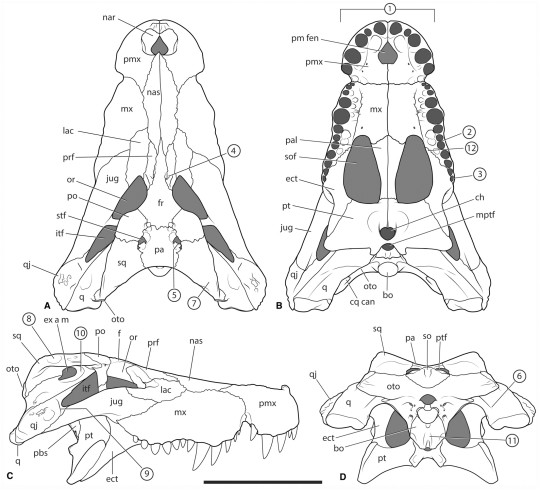
As a reminder, this animal stems from the Alcoota Fossil Site in Australia and dates to the Late Miocene, making it the youngest of the three recognized Baru species.
Previously this species was already referred to as being "the most robust Baru" and they weren't kidding. This thing looks more like something out of the Cretaceous than an animal that lived a mere 8 million years ago.
The morphology is interesting in many ways. Many of the ridges that are so prominent in Baru wickeni and less developed in Baru darrowi are absent. The seventh and eight tooth are so close they theres basically no space. Instead of four teeth like other Baru it has five in each premaxilla and the nasals reach the nares, like in Baru wickeni but unlike in Baru darrowi. The teeth also show the same small serrations as Baru darrowi and, unlike either of the other species, the jaws appear much less wavy not because they are but because the first festoon of the maxilla is followed up by a second one so developed it makes the first look almost flat.
It's a fascinating mosaic of characters that makes its relation to the other species a puzzling question. You'd think that the ridges for instance point at it being derived? After all wouldn't it make sense? Baru wickeni had the most developed rigdes, Baru darrowi smaller ones and Baru iylwenpeny none. Plus, the teeth of Baru wickeni are smooth unlike those of later forms. Yet at the same time....
The fact that it has five teeth instead of four and the fact that the nasals reach the nares are both ancestral traits, so you'd expect it to be closer to the base.
Left: Baru wickeni
Right: Baru darrowi
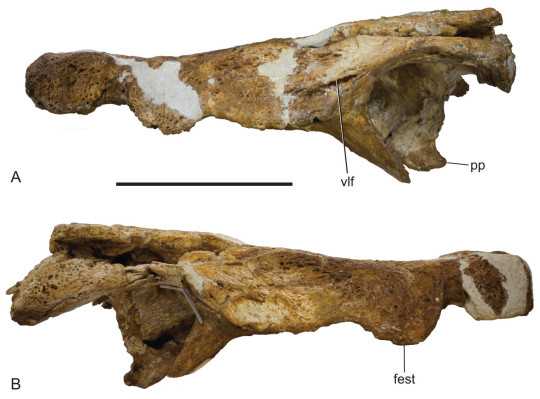
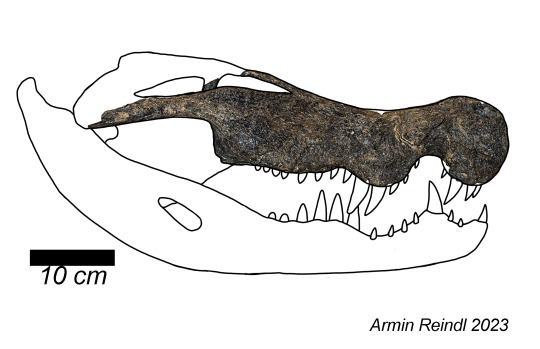
Well, while I think this isn't going to be the final place of this species among Baru, the most recent phylogenetic analysis suggests that Baru iylwenpeny was weirdly enough the basalmost species. Which means that it must have split from the other two species at the latest during the Late Oligocene and outlived the both of them without us ever knowing.
The paper also discusses how these animals may have gone extinct. If you look back at Kalthifrons, you might remember how I mentioned that mekosuchines kinda had a drop in diversity when transitioning from the Miocene to Pliocene. While the new paper avoids calling this a drop in diversity, it does highlight that there certainly was a turnover in fauna.
The reason is an old enemy of mekosuchines. Climate.
Yates and colleagues suggest that Australia was hit by an especially nasty dry period at the end of the Miocene, severe enough to drive Baru to its death but not severe enough to whipe out all mekosuchines. And after Baru was gone, Kalthifrons and Paludirex moved into the open niche.
There's also a final little piece of information that's not focused on yet really fascinating. Baru iylwenpeny had a friend. At least one other croc lived at the Alcoota site during the Late Miocene and tho it hasn't been studied in full yet, one thing is apparently known. It was a relative to the Bullock Creek taxon that coexisted with Baru darrowi and a relative to "Baru" huberi, the small croc that coexisted with Baru wickeni. This grouping has yet to be given a name, but its fascinating to me that each Baru species seemingly coexisted with a much smaller mekosuchine. Alas, like Baru this lineage seems to have fallen victim to climate change.
Baru wickeni and "Baru" huberi, in truth an unnamed genus.
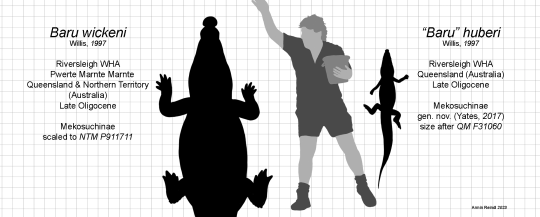
The paper is accessible here for those that wan't to dive deeper into the matter. I'll also be working on an updated size chart, this time featuring all three species of Baru, tho I can already tell you that despite being more robust its surprisingly not that much larger.
The last Baru (Crocodylia, Mekosuchinae): a new species of ‘cleaver‐headed crocodile’ from central Australia and the turnover of crocodylians during the Late Miocene in Australia (wiley.com)
#baru#baru iylwenpeny#alcoota baru#alcoota fossil site#miocene#paleontology#palaeoblr#crocs#crocodile#mekosuchinae#paleontology news#prehistory
95 notes
·
View notes
Text
Kalthifrons and the Fall of Mekosuchines
The penultimate singular mekosuchine I'll talk about here is Kalthifrons, one of the more obscure members of this clade. After all, Kalthifrons was named only in 2017 and unlike some other animals like Ultrastenos, it does not stand out as much morphologically. But I still wanna take a moment to talk about this medium-sized Pliocene croc, its potential fate and the implications for its relatives.
Left: The skull of Kalthifrons (Ristevski et al. 2023)
Right: A reconstruction of how the skull may have looked like intact


In many respects Kalthifrons looks very typical for a crocodilian, with a triangular head, rounded snout and eyes that face upwards. There are some interesting factors to mention, at least imo, and one thing thats sorta unknown. Starting with the unknown, what we aren't sure about is how deep the skull is. Sure the skull of Kalthifrons looks very intact in top view, but when looking at it from the side its about as flat as a sheet of paper. So we can't exactly tell how deep the skull would be. Maybe it was not much different from a modern croc...or maybe it was comparable to Baru the cleaver-headed crocodile. We simply don't know. The other two interesting things about its anatomy are more subtle. For one, the tip of the snout is comparably narrow. Now generally, if you look at mekosuchines the premaxilla and external nares tend to be wider than long, even in Australosuchus, but in Kalthifrons they are longer than wide. And then there's the frontal. The name Kalthifrons derives from the Latin word for forehead and the Dieri word for spear. The reason why is that the frontal bone, which covers the forehead, has an exceptionally long spear-like process at the front. Sure such a process is also found in other crocs, but in Kalthifrons it makes up 64% of this bones entire length.
A hypothetical reconstruction showing the size of Kalthifrons, which may have been around 3.4 meters.

With a length of possibly up to 3.4 meters and a triangular skull, Kalthifrons was probably a fairly generalist hunter. Fossils of Kalthifrons are known from a single place, the Golden Fleece Locality along the shores of Lake Palankarinna in the Lake Eyre basin, South Australia. Now this locality primarily yields two things. Croc fossils and turtles. Based on this and certain minerals in the sands of this locality, it has been suggested that the Golden Fleece Locality once housed a waterhole that dried up, leading to the deaths of its inhabitants.
The death of Kalthifrons as illustrated by Joschua Knüppe.
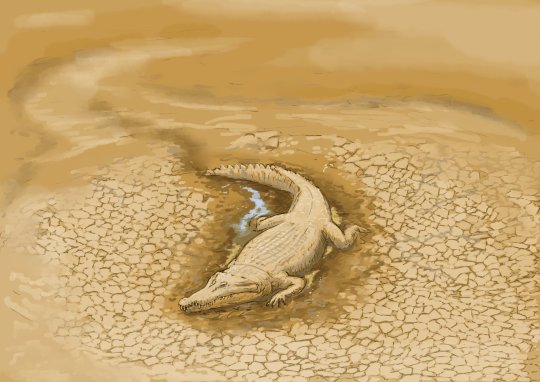
Which leads us to a bit of discussion regarding the general state of mekosuchines during the time of Kalthifrons. Now if you have read my previous posts on mekosuchines, you'll notice one thing. Most species native to continental Australia were around during the Oligocene to Miocene. Australosuchus, Baru, Ultrastenos, "Baru" huberi, Trilophosuchus and the continental Mekosuchus species. After the Miocene, continental species become rarer. Really you got Paludirex, Kalthifrons and Quinkana. And even they wouldn't stick around for much longer, with the last mekosuchines of Australia going extinct at the end of the Pleistocene.
So obviously mekosuchines experienced a drastic fall in diversity towards the end of the Miocene, clinging on for a few more million years before disappearing forever. But there's another thing that happened around this time. Modern crocodiles showed up. Contrary to popular belief, today's crocodiles of Australia are relatively recent arrivals. Freshwater crocodiles only lived there since the Pleistocene and saltwater crocodiles were likely even more recent, with both of them having evolved from different ancestors and arrived in Australia independently. But there's at least one more species of Crocodylus. The as of yet unnamed Tirari Desert Crocodile is known from remains that date to strata slightly more recent than that of Kalthifrons, displaying similar generalized anatomy. Like freshies and salties, the Tirari Crocodile arrived on its own, with phylogenetics indicating that its closest relatives were the palaeoafrican crocodiles like Crocodylus thorbjarnarsoni (a giant that grew up to 8 meters long).
Crocodylus species of Australia
Top left: The freshwater crocodile (Ristevski et al. 2023)
Bottom left: The saltwater crocodile (Ristevski et al. 2023)
Right: Stratigraphy of the Lake Eyre Basin and successions of local crocodilians (Yates and Pledge 2017)

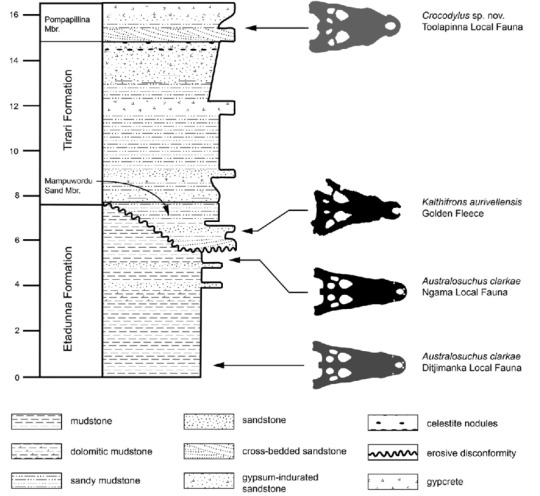
Did Crocodylus drive Kalthifrons to extinction? Well, maybe? Yates and Pledge discuss this possibility in the description of Kalthifrons, suggesting that theres some supporting pieces of information for this hypothesis. Not only does the arrival of the Tirari crocodile match up nicely with the disappearance of Kalthifrons, but they both share very similar anatomy. And conventional wisdom suggests that two crocs of the same morphotype don't really coexist in the same habitats.
But there's also points against that which aren't as openly discussed. Namely, the lack of material. Sure we have Kalthifrons in the older Mampuwordu Sand Member and the Tirari Crocodile in the younger Pompapillina Member, but remember. We only have that one Kalthifrons individual. We further know little about their habitat preferences. Sure conventional wisdom suggests crocs with similar morphology don't coexist, but that doesn't mean they don't overlap. Some species may very well be separated by the specific habitat they prefer. Slow open water, fast moving streams. Finally, is replacement necessarily the only answer? Not really. It has been deduced that Kalthifrons died in a drought and aridification is regarded as one of the main drivers of Australian megafauna extinction, as touched on in my summary of Paludirex. Maybe that's it? Kalthifrons was driven to extinction when environmental conditions grew too harsh, with Crocodylus entering the newly opened niche. This may parallel what happened in Miocene Africa, when rainforests disappeared osteolaemine crocodiles likely gave way to Crocodylus, which was better suited to the dryer climate.
Whatever the case, Kalthifrons is one of the most recent mainland mekosuchines and thus may be critical for us to determine what happened during this part of Australia's history. So sure it might not be flashy, but it's still an important little guy.
#mekosuchinae#kalthifrons#palaeoblr#prehistory#paleontology#pliocene#australia#croc#crocodilia#extinct#extinction#long post
90 notes
·
View notes
Note
About Kambara.
While the implementation is sloppy, isn't it still good to have minority languages represented in academia? And isn't it not that unusual to have a repetitive binomial, like with Crocodilus suchus as you've shown or Gorilla gorilla and the like?
Sorry if I sound a bit standoffish. Usually, complaints about nomenclature containing indigenous or other minority languages ping my suss radar, and I don't want folks to be encouraged to dismiss attempts at inclusion in science. Not that I think you were intending that, I mostly felt like as far as taxonomic names go, there can be far worse.
Rest assured that the post was meant to be somewhat tongue and cheek. I don't carry any ill will against Kambara taraina or the naming of it, rather I simply find it quite humerous that the authors went out of their way to make a redundant scientific name (which isn't as typical in fossil taxa as it is in modern ones), regardless of which language they chose to convey it in.
Kambara is definitely a great name and it goes along nicely with several other Australian crocodilians having been given names derived from indiginous languages.
Mekosuchus for example derives from Mek, the Drehu name of Grande Terre
Gunggamarandu combines Barunggam and Wakka Wakka words to mean "river boss" (which funnily enough is kind of just an alteration of Paludirex's name meaning swamp king)
Baru and Quinkana, two other iconic names imo, both derive their meaning from Dreamtime stories.
It's definitely a trend I hope to see continued, perhaps even with "Baru" huberi which is most likely in need of a distinct genus name anyways.
Outside of Australasia you also have stuff like Tsoabichi (from Shoshoni for monster), Voay (another instance of just crocodile but this time in Malagasy), Gnatusuchus (latinized Quechua for nose) and Kuttanacaiman (again from Quechua for cutting/grinding machine) to name a few.
4 notes
·
View notes
Text
16-foot crocodile nicknamed 'swamp king' was Earth’s terror millions of years ago
16-foot crocodile nicknamed ‘swamp king’ was Earth’s terror millions of years ago
An enormous 16-foot long crocodile nicknamed the “swamp king” that terrorized ancient waters a few million years ago has been identified.
The new species of prehistoric reptile, Paludirex vincenti (which in Latin means “swamp king Vincent,” after the late fossil collector Geoff Vincent) was discovered in Queensland, Australia, in the 1980s. It was only recently that researchers really examined…
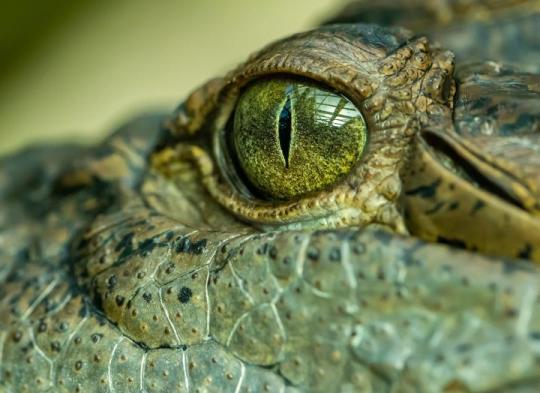
View On WordPress
0 notes